Need To Make a Boat Safe and Legal On The Water? We Can Help!
By: SurvivalAtSea.com | Liferaft Services
To begin with, it is required for every boat in the United States that uses a gas motor to be registered with the state in which it is primarily operated in. The seven digit combination of letters and numbers assigned by the state upon registration of the vessel must then be displayed on the front sides of the boat, along with the state issued registration sticker on the right side within six inches of the digits. After the process of registering a boat is complete, however, the United States Coast Guard requires that all vessels have certain Coast Guard approved safety gear, which varies depending on the length of the boat. Survival At Sea is proud to declare that we are able to provide all of the necessary items required to boat safely and legally at the best possible price. The following article will address all of the boating requirements, and make the process of gathering information and the necessary products quick and easy.
Boats Up To And Including 25 Feet Long
Vessels that are under sixteen feet are required to have one, properly fitting life jacket in usable condition for each person on board. It is important to make sure that the life jacket chosen is buoyant enough to be effective in the conditions it is being used in. For example, a boater often out in choppy ocean conditions should consider a life jacket with greater buoyancy than a boater who mostly spends time on small lakes or rivers. Furthermore, the life jacket should be suitable for whatever activity the wearer is participating in. For instance, a water skier must wear a different type of life jacket than someone staying on the boat as a passenger. Children under the age of thirteen are required by law to wear a life jacket while on board a vessel at all times unless in an enclosed area on the boat. Lastly, each boat must have on board a type IV throwable device to use in the event that a passenger falls out of the boat. The throwable boat cushions we offer are pictured below. We endorse them, given that they are a safe, stylish and affordable choice.
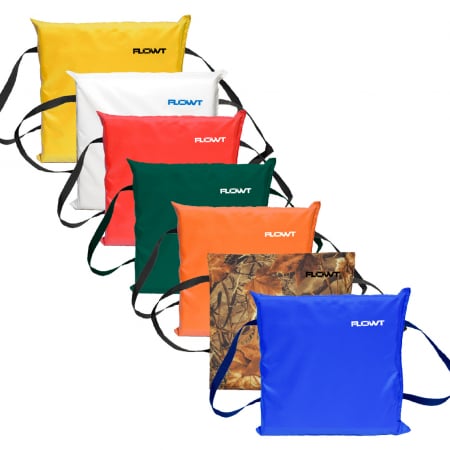
While throwable devices are not Coast Guard approved, it is still required for each vessel to have one. It is important to make sure that all life jackets on board are in a place that is easy to access, in case they need to be used in a timely manner. At Survival At Sea, we carry foam life jackets, inflatable life jackets, and hybrid life jackets. To learn more about life jackets and the products we carry, click here.
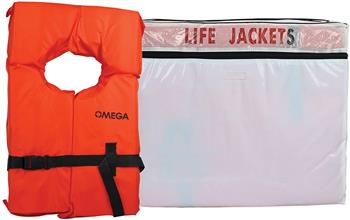
Pictured above is the most basic life jacket we carry that will make a boat legal on the water. For more information, click here.
Along with life jackets, each boat under sixteen feet must have visual distress signals designed for night use and a sound producing device. Boats between sixteen and twenty five feet must have three flares for day time use, and three flares for night time use. Whistles and horns adequately meet the audible signal requirements mentioned above. Technically, a navigation light is also required if the vessel will be operated during periods with limited visibility and at night. We recommend this addition to your boat, given that circumstances can always change when on the water. If the boat in question does not come equipped with lights, a lighting kit can be found here.
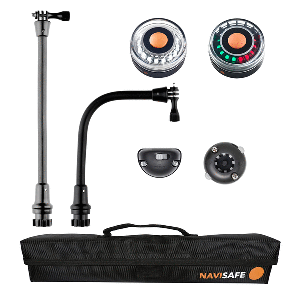
Pictured is a lighting kit that we carry which works perfectly for smaller boats that do not come equipped with any sort of light fixtures.
The last requirement that some boats twenty five feet and shorter need to meet is to have one B-1 fire extinguisher on board, if the gas tank is built into the boat. Given this guideline, vessels like dinghies or jon boats are exempt from this. Given the risk that comes with having gasoline on board and operating a motor though, we encourage all boaters to have some sort of fire extinguisher on their vessel.
Boats Between 26 And 39 Feet (Inclusive)
For boats in this category, the same rules as above regarding life jackets and throwable devices exist. On these vessels, however, either two B-1 or one B-2 type of fire extinguisher is required. Additionally, with the exclusion of sailboats and other vessels less than twenty six feet lacking motors, a minimum of three day time and three night time flares in usable condition are required to be on the boat in an easily accessible place.
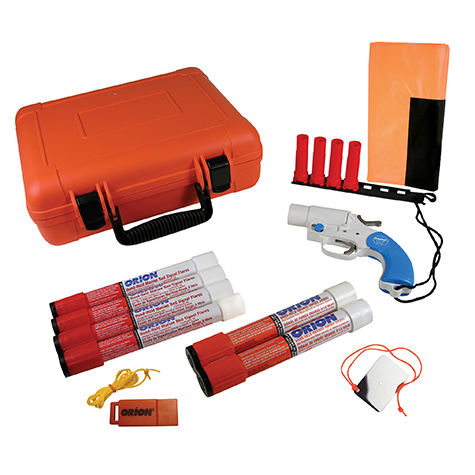
Pictured above is a flare kit. Kits like this as well as other options can be found on our website or by clicking the word “flares” above.
Boats in this category are also required to have a sound producing device able to sound a four second signal that can be heard half a mile away. While most boats in this range will come with this type of system, our website offers plenty of external devices that meet this criteria.
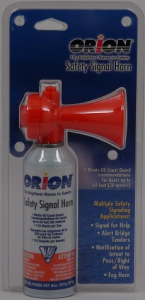
The airhorn pictured above is a great, affordable option we offer that meets Coast Guard Requirements. To view it on our website, click here.
The last item that boats in this category are required to have are signs stating the rules regarding oil and garbage waste from the boat.
Boats Between 40 And 64 Feet (Inclusive)
For boats in this category, the same rules listed above regarding life jackets and throwable devices exist. These vessels must have three B-1 fire extinguishers, or one B-1 type with one B-2 type. As with some of the smaller boats, these vessels are required to have three day time and three night time flares on board. A sound making device is required for these vessels that is able to audibly signal half a mile away for four seconds. Additionally, oil and garbage placards are required to be hung on the boat in a visible location.